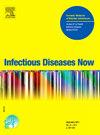Estimating the number and incidence of carbapenemase-producing Enterobacterales infections in France in 2020: A capture-recapture study
IF 2.2
4区 医学
Q2 INFECTIOUS DISEASES
引用次数: 0
Abstract
Objectives
Even though France faces few severe infections due to carbapenem-producing Enterobacterales (CPE), inter-regional epidemic stages render their dissemination a cause for considerable concern. CPE reporting relies in France on three non-exhaustive monitoring systems (MS): an early-alert system, a nationwide passive surveillance system and the National Reference Centre. We aim to estimate the number and incidence of CPE-related infections in France in 2020 and to identify any overlap between the three systems to determine whether their continued use still serves a purpose.
Methods
Data on clinical CPE isolates in 2020 were extracted from the three MS databases. Screening samples were excluded. Datasets were manually merged, isolate by isolate, so as to identify in which system(s) each isolate was reported. A system-participant was defined as any declarant reporting at least one isolate in an MS. Using our matched dataset, we performed Bayesian model averaging for capture-recapture estimations.
Results
All in all, 1722 CPE isolates were reported through the monitoring systems in 2020. We estimated that the number of CPE infections was almost twice this number, corresponding to incidence of 0.031 CPE/1000 hospital-days [CI95% 0.015–0.057/1,000 hospital-days], with regional disparities taken into account. Among participating the laboratories, 86% were involved in only one of the systems. Among clinical CPE isolates, 56% were isolated from urine.
Conclusion
Regarding this rare infection, surveillance based only on passive surveillance from voluntary hospitals does not reflect actual epidemiology. We recommend maintaining the three monitoring systems and improving the participation of hospitals’ nationwide surveillance, the objective being to more accurately capture the real incidence of CPE infections.
估计2020年法国产碳青霉烯酶肠杆菌感染的数量和发生率:一项捕获-再捕获研究。
目的:尽管法国因产碳青霉烯类肠杆菌(CPE)引起的严重感染很少,但区域间的流行阶段使其传播引起了相当大的关注。在法国,CPE报告依赖于三个非详尽的监测系统:一个早期预警系统、一个全国性的被动监测系统和国家参考中心。我们的目标是估计2020年法国cpe相关感染的数量和发生率,并确定三个系统之间的任何重叠,以确定它们是否仍然继续使用。方法:从3个MS数据库中提取2020年临床CPE分离株数据。排除筛选样本。手动合并数据集,逐个隔离,以便确定每个隔离报告在哪个系统中。系统参与者被定义为在ms中报告至少一个隔离的任何声明者。使用我们匹配的数据集,我们对捕获-再捕获估计执行贝叶斯模型平均。结果:2020年通过监测系统共报告CPE分离株1722株。我们估计CPE感染的数量几乎是这个数字的两倍,对应于0.031 CPE/1000医院日的发病率[CI95% 0.015-0.057/ 1000医院日],并考虑了地区差异。在参与的实验室中,86%只参与了其中一个系统。临床CPE分离株中,56%从尿液中分离得到。结论:对于这一罕见的感染,仅依靠自愿医院的被动监测不能反映实际的流行病学情况。我们建议维持这三个监测系统,并提高医院参与全国监测的程度,目的是更准确地捕捉CPE感染的真实发生率。
本文章由计算机程序翻译,如有差异,请以英文原文为准。
求助全文
约1分钟内获得全文
求助全文
来源期刊

Infectious diseases now
Medicine-Infectious Diseases
CiteScore
7.10
自引率
2.90%
发文量
116
审稿时长
40 days
 求助内容:
求助内容: 应助结果提醒方式:
应助结果提醒方式:


